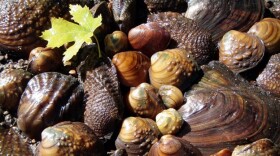Who doesn’t like cranberries? In fact, I had them with dinner last night. I enjoy cranberries several nights a week. Of course, cranberries with chicken dinner is a must. If you are a fan of biscuits & gravy, next time try it with a side of cranberries. You won’t be disappointed. What are we talking about today? You guessed it – cranberries, specifically, wild cranberries that grow on the bogs of the Northwoods.
Wild cranberries fall into the genus Vaccinium. We have the small cranberry (Vaccinium oxycoccus) at Kemp Station. Other species of wild cranberry are native to the Wisconsin, Minnesota and Michigan region including the large cranberry and northern mountain cranberry. The cranberry is a low-growing, trailing, woody evergreen vine. Fruit are born on short vertical shoots called uprights. An upright can grow erect for one or two seasons before its weight bends it downward and new vertical growth is produced at the tip or from side buds along the stem. Cranberry leaves are small and attached to the stem with a very short petiole. Leaves typically persist for two years. Like other plants, evergreen leaves do not equal last forever. Evergreens like red and white pine needles only last for a few years before they fall and are replaced.
Wisconsin ranks first in United States in cultivated cranberry production. You have likely seen pictures of cultivated cranberries or maybe you have toured one of our local cranberry marshes. During harvest time, the bogs are flooded for harvesting, and the cranberries float to the top. A bright red matt of cranberries covers the water surface. In a typical 2-acre marsh, there are millions of cranberries, more than 8 million cranberries per acre. What does this have to do with wild cranberries? For comparison, wild cranberries are not nearly as productive as their cultivated cousins.
A few years ago, my two boys and I set out to pick wild cranberries at Kemp Station. We have several floating bogs on station, the perfect environment for the wild plants. My boys quickly pointed out that I kept sinking the bog when I got too close to them. This was entirely true given the fact that I don’t skip many meals.
Remember the more than 8 million cranberries per acre I mentioned earlier. Wild cranberries are not nearly as productive. After two hours of picking on two separate bogs, we harvested a total of 1-1/2 cups! Cultivated cranberries are measured in 100-pound barrels, with an average of around 200 barrels per acre.
We were proud of our 1-1/2 cups and brought them home. We used my mom’s recipe for cranberry sauce. A bit of math was involved to reduce the recipe since the it called for 4 pounds of cranberries, not 1-1/2 cups. To our delight, the wild cranberry sauce tasted just like mom used to make, a treat for us all.
Why the lack of production on the bogs at Kemp? Consider the nutrient poor environment of the bog. Compared to a cultivated commercial cranberry marsh with fertilization, insect management, disease management and irrigation, wild cranberries don’t have any easy life. And we weren’t the only animals picking the wild cranberries. We were competing with many types of birds and small mammals that find wild cranberries tasty.
Your challenge this week is to take a walk in the forest. Find those bog areas that are home to the wild cranberry. If you are lucky, you too will find a few berries, but start early. It takes a long time to pick a cup!









